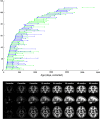Characterizing longitudinal white matter development during early childhood
- PMID: 24710623
- PMCID: PMC4481335
- DOI: 10.1007/s00429-014-0763-3
Characterizing longitudinal white matter development during early childhood
Abstract
Post-mortem studies have shown the maturation of the brain's myelinated white matter, crucial for efficient and coordinated brain communication, follows a nonlinear spatio-temporal pattern that corresponds with the onset and refinement of cognitive functions and behaviors. Unfortunately, investigation of myelination in vivo is challenging and, thus, little is known about the normative pattern of myelination, or its association with functional development. Using a novel quantitative magnetic resonance imaging technique sensitive to myelin we examined longitudinal white matter development in 108 typically developing children ranging in age from 2.5 months to 5.5 years. Using nonlinear mixed effects modeling, we provide the first in vivo longitudinal description of myelin water fraction development. Moreover, we show distinct male and female developmental patterns, and demonstrate significant relationships between myelin content and measures of cognitive function. These findings advance a new understanding of healthy brain development and provide a foundation from which to assess atypical development.
Figures






References
-
- Aubert-Broche B, Fonov VS, García-Lorenzo D, Mouiha A, Guizard N, Coupé P, Eskildsen SF, Collins DL. A new method for structural volume analysis of longitudinal brain MRI data and its application in studying the growth trajectories of anatomical brain structures in childhood. Neuroimage. 2013;82:393–402. doi: 10.1016/j.neuroimage.2013.05.065. - DOI - PubMed
Publication types
MeSH terms
Grants and funding
LinkOut - more resources
Full Text Sources
Other Literature Sources
Medical

